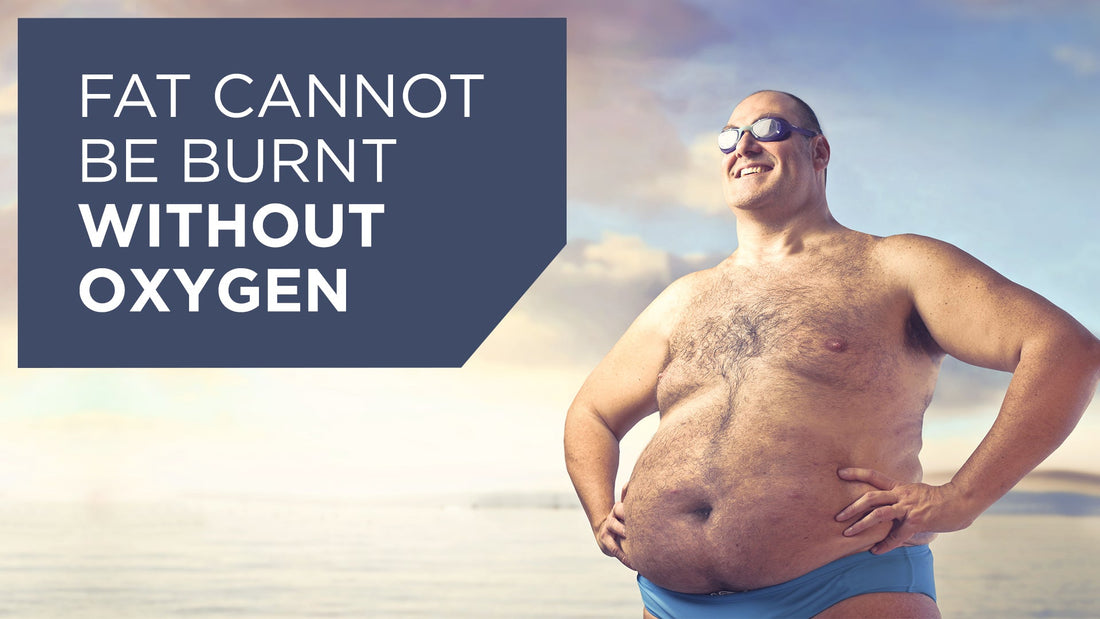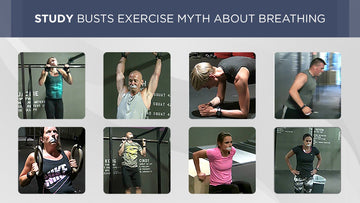
Increase your ability to burn fat with breathing retraining
Would you like to increase your fat loss but don’t know how? Do you keep trying to lose weight but fail again and again? Doesn’t the advice to, “just eat less” actually work? Maybe you’ve tried various diets and actually lost weight, but put it back on again when the motivation floundered, or you got fed up with the diet. Is it possible to lose weight by improving our breathing habits? Yes it is!
Weight loss advice generally doesn’t include improving your breathing habits, although it’s a simple yet often overlooked way to both increase fat metabolism and improve digestion and thereby lose weight.
When we understand how our body works and give it what it wants, weight loss doesn’t have to be a struggle.
Over breathing leads to overweight
Many of us have a respiratory rate twice as fast as is should be, or even more, which can be likened to eating twice as many meals as you need, i.e., double breakfasts, lunches and dinners. By putting yourself on an “air diet,” i.e. slowing down your breathing rate and breathing less, you reset the balance between oxygen and carbon dioxide, which will improve your digestion and speed up your fat metabolism.
To produce energy your body uses two main types of fuel: fat and carbohydrates (sugar/glucose).
Calories are a way to measure the amount of energy, and in total, around 2,000–2,500 calories of glucose are stored in the body at any one time. The number of calories stored as fat is considerably higher, and depending on whether you are thin or overweight, it can vary from about 50,000 calories up to several hundred thousand.

Fat cannot be burned without oxygen
There are a number of studies confirming the connection between impaired lung function and being overweight. In a review of nine studies the researchers conclude “The obese individuals had a reduced lung volume and lung capacity as compared to healthy individuals.”
So your fat reserves are approximately 50 times larger, or even more, than your sugar-reserves and they contain nearly unlimited amounts of energy. Oxygen must be present in your cells for fat to be broken down at all.
When we breathe inefficiently, less oxygen will reach the cells, which can be viewed as we are closing the door slightly to our fat reserves, and a greater proportion of carbohydrates than normal will be used to produce energy. The relatively small amount of carbohydrates stored will be used up faster than planned, and that is when we get sugar cravings.
The connection between impaired breathing, fatigue and being overweight
With obesity it is common that the sleep is poor and the energy low. A compilation shows that nearly half of those doing Conscious Breathing Retraining for four weeks experience a big improvement in their sleep.
A reason for this remarkable improvement is that mouth breathing at rest is equal to over breathing and oxygen deficiency which in turn leads to a stressed nervous system and less deep sleep. When we start to sleep with our mouth closed our oxygenation is improved which calms down the brain and the sleep will be deeper and more relaxed.
It is also much more efficient to produce energy with oxygen than without. Impaired breathing habits means that less oxygen reaches the muscles and organs which in effect produces less energy in the cells.
Up to 16 times less energy is produced per glucose molecule when oxygen is not available, and consequently less work can be performed. The energy crisis is perceived by our body as malnutrition when, in fact, we are suffering from a lack of oxygen.
Improve your breathing when having sugar cravings and low energy
When our ability to produce energy with oxygen decreases, we compensate by increasing anaerobic energy production (without oxygen). If oxygen is lacking, the only source available to produce energy from is sugar, and the vast consumption of sugar in our society can be interpreted as a sign of a deteriorating ability to produce energy, due to oxygen deficiency. A sedentary lifestyle and overindulgence in the consumption of simple carbohydrates combined with over-breathing means that most of us are simply suffering from energy deficiency.
When we hit the all-too-common afternoon energy dip we tend to try to resolve the problem by eating cookies and sweets, drinking tea or coffee, or downing sodas and energy drinks. When we improve our breathing habits and thereby increase our ability to burn fat, we also reduce the need to refill with simple carbohydrates and other stimulating foods like coffee, sodas and energy drinks to keep our energy up during the day.
Many of the simple carbohydrates we eat when we are low on energy creates an acidic environment in our body. For example, sugar creates a favorable breeding ground for bacteria found in your mouth. The waste from these bacteria is acidic, i.e., at a low pH level, which corrodes the teeth. Your body’s innate response to acid-producing food and drinks is to increase respiration in order to eliminate more carbon dioxide, which increases pH, in an attempt to restore the pH level in your blood. The risk of establishing poor breathing habits arises and can easily end in a vicious circle.
Next time you crave sugar or feel low on energy, try to focus on your breathing pattern and make it low, slow and rhythmic. The easiest way to achieve this low, slow and rhythmic breathing is by prolonging your exhalation and only breathe through your nose. You can also try drinking water, as increasing your hydration levels can help stave off cravings. Yet another tip is to take a short walk since light gives us energy. I suggest that you also apply Conscious Breathing during the walk.
Respiratory Quotient shows which energy source that is used
Respiratory Quotient (RQ) is the measure of how much energy is derived from carbohydrates and fats, respectively. At rest, a higher proportion of our total energy consumption usually comes from fat and a smaller share from carbohydrates. The dominant energy source is calculated by using a gas analyzer that measures the composition of the gas in exhaled air. The gas analyzers can be found in hospitals and certain training labs.
Respiratory Quotient (RQ) = production of carbon dioxide / consumption of oxygen. Sugar has a respiratory quotient of 1.0, as it takes 6 oxygen molecules to create 6 carbon dioxide molecules. For fat it is 0.7, as it takes 23 oxygen molecules to create 16 carbon dioxide molecules. The higher the RQ value, the greater proportion of the fuel in the energy production is provided by carbohydrates.
| Fat and glucose as energy source respectively | ||
|---|---|---|
| RQ 0.7 | 100% fat | 0% glucose |
| RQ 0.75 | 83% fat | 17% glucose |
| RQ 0.8 | 67% fat | 33% glucose |
| RQ 0.85 | 50% fat | 50% glucose |
| RQ 0.9 | 33% fat | 67% glucose |
| RQ 0.95 | 17% fat | 83% glucose |
| RQ 1.0 | 0% fat | 100% glucose |
In a Finnish study on 16 individuals suffering from hyperventilation syndrome (HVS), the number of breaths per minute, respiratory volume, and the amount of carbon dioxide in the exhaled air were measured and compared with a control group that consisted of 13 healthy subjects. Measurements were taken lying down after a ten-minute rest, and standing up after being in an upright position for eight minutes.
At rest there were no major differences between the HVS group and the control group, but when they stood up for eight minutes the differences became pronounced:
The results confirmed that those with poor respiration use a higher proportion of carbohydrates to produce energy.

Impaired breathing makes it harder to maintain weight loss
A Czech study followed up on the weight of obese people who had started a low calorie diet two years earlier. It was found that those who first lost weight and then gained it back again had a high RQ, i.e., they used more carbohydrates in general to produce energy. Those who managed to maintain the lower weight, however, had significantly lower RQ levels.
The results showed that it is harder to both lose weight and to maintain weight loss when our respiration is ineffective. This is because breathing inefficiently causes oxygen deficiency. Since fat cannot be converted to energy without oxygen, our body will switch from burning fat to burning carbohydrates when our breathing is impaired. So if we’re trying to lose weight, and at the same time over-breathe and/or breathe irregularly, it will be more difficult to keep the weight off because our body is set to burn sugar.
This article is based on the book Conscious Breathing. Thank you for taking the time to read this, I hope you enjoyed it ?
Scientific references
Title: Obesity and lung function: a systematic review. Link to full text ![]()
Journal: Einstein (São Paulo) vol.12 no.1 São Paulo Jan./Mar. 2014
Author: Melo LC et. al
Abstract: Obesity is a chronic disease characterized by the excessive accumulation of body fat that is harmful to the individuals. Respiratory disorders are among the comorbidities associated with obesity. This study had the objective of investigating the alterations in respiratory function that affect obese individuals. A systematic review was performed, by selecting publications in the science databases MEDLINE and LILACS, using PubMed and SciELO.The articles that assessed pulmonary function by plethysmography and/or spirometry in obese individuals aged under 18 years were included. The results demonstrated that the obese individuals presented with a reduction in lung volume and capacity as compared to healthy individuals. Reduction of total lung capacity and reduction of forced vital capacity, accompanied by reduction of the forced expiratory volume after one second were the most representative findings in the samples. The articles analyzed proved the presence of a restrictive respiratory pattern associated with obesity.
Title: Orthostatic increase of respiratory gas exchange in hyperventilation syndrome. Link to full text ![]()
Journal: Thorax. 2000 Apr;55(4):295-301
Author: Malmberg LP et. al
Abstract:
BACKGROUND:Hyperventilation syndrome (HVS) is a common disorder which is difficult to diagnose because of somatic symptoms and its episodic nature. In previous studies respiratory alkalosis in arterial blood was often found during orthostatic tests in patients with HVS. The purpose of this study was to assess these orthostatic changes by non-invasive pulmonary gas exchange measurements and to evaluate whether these responses discriminate patients with HVS from healthy subjects.
METHODS:Respiratory gases were collected with a face mask and pulmonary gas exchange was measured after 10 minutes at rest and after eight minutes standing upright in 16 patients with HVS and 13 healthy control subjects. In patients with HVS arterial blood samples were also drawn at rest and in the standing position.
RESULTS:At rest the variables of respiratory gas exchange did not differ significantly between the groups. As a response to standing, minute ventilation increased in both study groups but significantly more in the patients with HVS (mean difference 5.4 l/min (95% CI 1.1 to 9.6)). The changes in end tidal CO(2) fraction (FETCO(2)) and in ventilatory equivalents for oxygen (VE/VO(2)) and for CO(2) (VE/VCO(2)) during the orthostatic test were also significantly larger in patients with HVS than in healthy controls. During standing FETCO(2) was significantly lower (mean difference -1.1 kPa; 95% CI -1.5 to -0.6) and VE/VO(2) (mean difference 18.4; 95% CI 7.7 to 29.0) and VE/VCO(2) (mean difference 11.7; 95% CI 4.8 to 18.6) were significantly higher in HVS patients than in healthy controls. By using the cut off level of 4% for FETCO(2) the sensitivity and specificity of the test to discriminate HVS were 87% and 77%, respectively, and by using the cut off level of 37 for VE/VO(2) they were 93% and 100%, respectively. In the HVS patients arterial PCO(2) and FETCO(2) were closely correlated during the orthostatic test (r = 0.93, p<0.0001).
CONCLUSIONS:As a response to change in body position from supine to standing, patients with HVS have an accentuated increase in ventilation which distinguishes them from healthy subjects. These findings suggest that non-invasive measurements of pulmonary gas exchange during orthostatic tests are useful in the clinical evaluation of patients with hyperventilation disorders
Title: Respiratory quotient in obesity: its association with an ability to retain weight loss and with parental obesity
Journal: Sb Lek. 2000;101(1):99-104
Author: Hainer V och medarbetare
Abstract: A high fasting respiratory quotient (RQ) was observed during the treatment by very low calorie diet (VLCD) in obese patients who regained weight at two-year follow-up (weight regainers) or in those who exhibited repeated cycles of weight loss with a subsequent weight regain (weight cyclers). In contrast obese patients who succeeded to retain the weight loss achieved initially by the VLCD at 2-yr follow-up (weight losers) or those who did not exhibit weight fluctuations (weight noncyclers) were characterized by a significantly lower RQ. Therefore a high fasting RQ during the VLCD treatment should be considered predictive of body weight gain.Resting metabolic rate (RMR) expressed per kg fat free mass (FFM) did not influence body weight changes. A high RQ revealed in obese subjects reporting parental obesity and a low fasting RQ observed in those obese without family history of obesity suggest a role of hereditary factors in the ability to oxidize fat in severely obese subjects. In contrast, parental history of obesity did not affect RMR in severely obese individuals.







